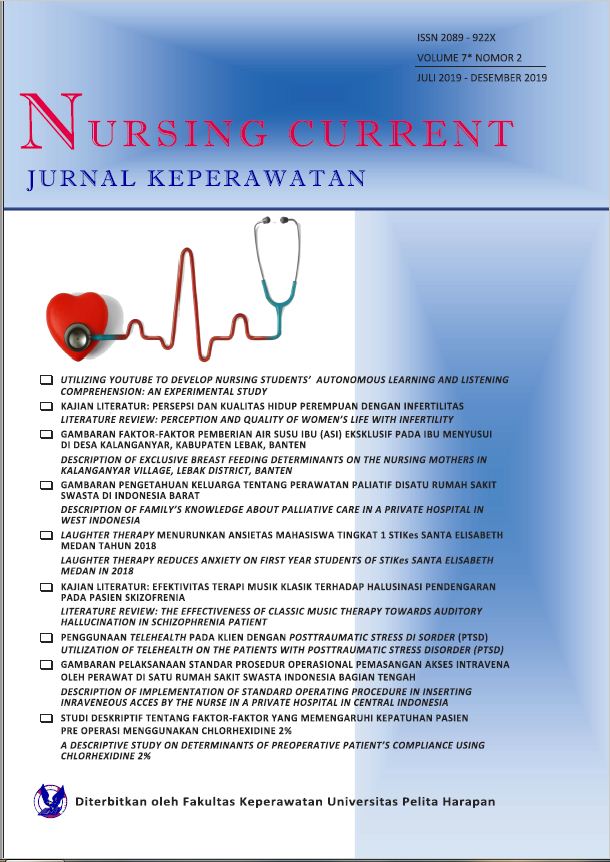LAUGHTER THERAPY REDUCES ANXIETY IN FIRST YEAR STUDENTS OF STIKes SANTA ELISABETH MEDAN IN 2018 [LAUGHTER THERAPY MENURUNKAN ANSIETAS MAHASISWA TINGKAT I STIKES ELISABETH MEDAN TAHUN 2018]
DOI:
https://doi.org/10.19166/nc.v7i2.2312Λέξεις-κλειδιά:
Anxiety, Laughter Therapy, StudentsΠερίληψη
Anxiety is a reaction that anyone can experience. Excessive anxiety will hinder a person's function in his life. Students often experience anxiety, as a result of psychosocial factors, where students do not respond appropriately to stressors, for example, new environmental situations. Laughter therapy is a powerful antidote to stress, illness and conflict. The purpose of this study was to determine the effect of child therapy on the anxiety of first-year students of STIKes/Health Institute of Santa Elisabeth Medan in 2018. The research design applied One Group Pre-Post Test Design. The sampling technique was selected using quota sampling, with a total sample of 63 people. The results of the study revealed that the average anxiety level of the students was 1.83 before being given the laughter therapy. After the laughter therapy, the average of students’ anxiety level decreased into 0.98. The Wilcoxon test showed the comparison score before and after the therapy, with p value 0.0001 (p <0.05). This also means that there was an effect of laughter therapy on the anxiety of students at STIKes Santa Elisabeth Medan in 2018. From the research results, it is expected that students should experience the laughter therapy to reduce their anxiety and manage to more calm and relaxed.
BAHASA INDONESIA Ansietas adalah reaksi yang dapat dialami siapapun. Rasa cemas yang berlebihan akan menghambat fungsi seseorang dalam kehidupannya. Mahasiswa sering mengalami cemas, akibat dari faktor psikososial, dimana mahasiswa tidak merespon secara tepat terhadap stressor misalnya terhadap situasi lingkungan yang baru. Laughter therapy atau terapi tawa merupakan penangkal stres, sakit dan konflik yang kuat. Tujuan penelitian ini untuk mengetahui pengaruhlaughter therapy terhadap ansietas mahasiswa tingkat I STIKes Santa Elisabeth Medan Tahun 2018. Desain penelitian menggunakan rancangan One Group Pre-Post Test Design. Teknik pengambilan sampel dipilih dengan menggunakan quota sampling, denganrjumlah sampel sebanyak 63 orang. Hasil penelitian sebelum diberikan laughter therapy, rata-rata tingkat ansietas 1,83. Kemudian setelah diberikan laughter therapy terdapat penurunan menjadi 0,98. Uji statistik yang digunakan adalah uji Wilcoxon dengan nilai p value = 0,0001 (p < 0,05) yang berarti ada pengaruh laughter therapy terhadap ansietas mahasiswa tingkat I STIKes Santa Elisabeth Medan tahun 2018. Dari hasil penelitian di harapkan mahasiswa dapat melakukan laughter therapy sehingga dapat mengurangi kecemasan yang dialami dan membuat lebih tenang dan rileks.
Αναφορές
Chandratika, D., & Purnawati, S. (2014). Gangguan Cemas pada Mahasiswa Semester I dan VII Program Studi Pendidikan Dokter Fakultas Kedokteran Universitas Udayana. EJurnal Medika Udayana, 3(4). https://ojs.unud.ac.id/index.php/eum/article/view/13290
Demir, M. (2015). Effects of Laughter Therapy on Anxiety, Stress, Depression and Quality of Life in Cancer Patients. Journal of Cancer Science & Therapy, 7(9). https://doi.org/10.4172/1948-5956.1000362
Desinta, S. & Ramdhani, N. (2013). Terapi Tawa Untuk Menurunkan Stres Pada Penderita Hipertensi. Jurnal Psikologi, 40(1). https://jurnal.ugm.ac.id/jpsi/article/view/7063
Dhivagar, S., Prabavathy, S., & Renuka, K. (2016). A Study To Assess The Efectiveness of Laughter Therapy On Stress And Anxiety Among Elderly At Selected Old Age Home, Puducherry. Internnational Journal of Information Research and Review, 3(12), 3459-3463. https://www.ijirr.com/sites/default/files/issues-pdf/1624.pdf
Hasianna, S. T., Surawijaya, A. K., & Maulana, T. A. (2014). Gambaran Tingkat Kecemasan pada Mahasiswa Semester Satu di Fakultas Kedokteran Kristen Maranatha Tahun 2014. Medical Journal, 5(2).
Kaur, L., & Walia, I. (2008). Effect of Laughter Therapy On Level Of Stress: A Study Among Nursing Students. Nursing and Midwifery Research Journal, 5(1). https://doi.org/10.33698/NRF0074
Kim, S. H., Kim, Y. H., & Kim, H. J. (2015). Laughter and Stress Relief in Cancer Patients: A Pilot Study. Evidence-Based Complementary and Alternative Medicine, 2015, 1-6. https://doi.org/10.1155/2015/864739
Mikhaline, C. (2015). Pengaruh Terapi Tertawa Terhadap Penurunan Skor Depresi Pada Lanjut Usia (Lansia) Di Panti Graha Werdha Marie Joseph Kota Pontianak. Jurnal ProNers, 3(1).
Monk, M. F. (2012). Gentle Therapy. America: Inspiring Voices.
Nurwela, T. S., Mahajudin, M. S., & Adiningsih, S. (2017). The effectiveness of laugh therapy to decrease depression level in the elderly at Griya Usila st. Yosep Surabaya and panti werdha Bhakti Luhur Sidoarjo. Jurnal Ilmiah Kedokteran Wijaya Kusuma, 4(1), 62. https://doi.org/10.30742/jikw.v4i1.20
Notoatmodjo, S. (2012). Metodologi Penelitian Kesehatan. Jakarta: Rineka Cipta.
Prasetyo, A. R., Nurtjahjanti, H., Fauziah, N., & Kustanti, E. R. (2016). Penurunan Tingkat Stres Kerja Pada Penerbang Militer Melalui Penerapan Terapi Yoga Tawa. Jurnal Psikologi Undip, 15(1), 11. https://doi.org/10.14710/jpu.15.1.11-20
Sellakumar, G. K. (2015). Effect of Slow-Deep Breathing Exercise to Reduce Anxiety among Adolescent School Students in a Selected Higher Secondary School in Coimbatore, India. Journal of Psychological & Educational Research, 23(1), 54-72.
Setyoadi & Kushariyadi. (2011). Terapi Modalitas Keperawatan pada Klien Psikogeriatrik. Jakarta: Salemba Medika.
Umamah, F., & Hidayah, L. (2017). Pengaruh Terapi Tertawa Terhadap Tingkat Depresi Pada Lansia Di Panti Uptd Griya Wreda Surabaya. Jurnal Ilmiah Kesehatan (Journal of Health Sciences), 10(1). https://doi.org/10.33086/jhs.v10i1.147
Widyartini, N. W. E., & Diniari, N. K. S. (2016). Tingkat Ansietas Siswa Yang Akan Menghadapi Ujian Nasional Tahun 2016 Di SMA Negeri 3 Denpasar. E-Jurnal Medika Udayana, 5(6). https://ojs.unud.ac.id/index.php/eum/article/view/20724
Λήψεις
Δημοσιευμένα
Πώς να δημιουργήσετε Αναφορές
Τεύχος
Ενότητα
Άδεια
Authors who publish with this journal agree to the following terms:
1) Authors retain copyright and grant the journal right of first publication with the work simultaneously licensed under a Creative Commons Attribution License (CC-BY-SA 4.0) that allows others to share the work with an acknowledgement of the work's authorship and initial publication in this journal.
2) Authors are able to enter into separate, additional contractual arrangements for the non-exclusive distribution of the journal's published version of the work (e.g., post it to an institutional repository or publish it in a book), with an acknowledgement of its initial publication in this journal.
3) Authors are permitted and encouraged to post their work online (e.g., in institutional repositories or on their website). The final published PDF should be used and bibliographic details that credit the publication in this journal should be included.

This work is licensed under a Creative Commons Attribution-ShareAlike 4.0 International License.






